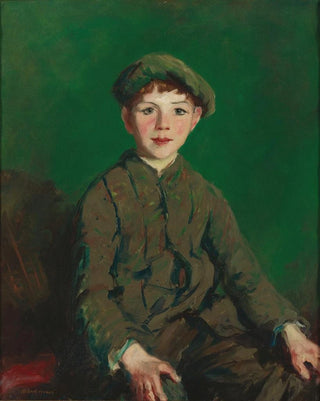Art print | Irish Boy - Robert Henri


View from behind

Frame (optional)
In the vast panorama of American art history, the artwork "Irish Boy" by Robert Henri stands out for its emotional depth and authenticity. This painting, which captures the very essence of childhood through the gaze of a young boy, invites the viewer to immerse themselves in a universe that is both simple and rich. Henri, a prominent figure of the realist movement, manages to transcend everyday life by offering a vision that is both personal and universal of his subject. The soft light bathing the boy's face, as well as the sparkle in his bright eyes, evoke a palpable nostalgia and a human connection that resonates deeply.
Style and uniqueness of the artwork
Robert Henri's style is characterized by his incisive approach and his ability to seize the present moment. In "Irish Boy," the technique of loose and energetic brushwork gives the piece a unique vitality. The colors, though earthy, vibrate with an intensity that captures the eye and the mind. Henri does not merely depict a child; he succeeds in encapsulating innocence and curiosity of childhood, while subtly evoking the Irish cultural environment. The background, blurred and suggestive, highlights the figure of the boy, creating a dialogue between the individual and their context. This artwork is a true ode to the beauty of everyday life, a celebration of the small things that often go unnoticed.
The artist and his influence
Robert Henri, born in 1865, is one of the leading figures of the Ashcan movement, which highlighted American urban life in the early 20th century. This artist, influenced by masters such as Diego Velázquez and Édouard Manet, has always sought to represent the reality of his time with a unique sensitivity. Henri was not only a prolific painter but also a mentor to many artists, encouraging a freer and more expressive approach to painting. His impact on American art is undeniable, as he paved the way for a deeper reflection on identity and human experience. Through "Irish Boy," he leaves a lasting imprint, reminding us that art can be both accessible and

Matte finish

View from behind

Frame (optional)
In the vast panorama of American art history, the artwork "Irish Boy" by Robert Henri stands out for its emotional depth and authenticity. This painting, which captures the very essence of childhood through the gaze of a young boy, invites the viewer to immerse themselves in a universe that is both simple and rich. Henri, a prominent figure of the realist movement, manages to transcend everyday life by offering a vision that is both personal and universal of his subject. The soft light bathing the boy's face, as well as the sparkle in his bright eyes, evoke a palpable nostalgia and a human connection that resonates deeply.
Style and uniqueness of the artwork
Robert Henri's style is characterized by his incisive approach and his ability to seize the present moment. In "Irish Boy," the technique of loose and energetic brushwork gives the piece a unique vitality. The colors, though earthy, vibrate with an intensity that captures the eye and the mind. Henri does not merely depict a child; he succeeds in encapsulating innocence and curiosity of childhood, while subtly evoking the Irish cultural environment. The background, blurred and suggestive, highlights the figure of the boy, creating a dialogue between the individual and their context. This artwork is a true ode to the beauty of everyday life, a celebration of the small things that often go unnoticed.
The artist and his influence
Robert Henri, born in 1865, is one of the leading figures of the Ashcan movement, which highlighted American urban life in the early 20th century. This artist, influenced by masters such as Diego Velázquez and Édouard Manet, has always sought to represent the reality of his time with a unique sensitivity. Henri was not only a prolific painter but also a mentor to many artists, encouraging a freer and more expressive approach to painting. His impact on American art is undeniable, as he paved the way for a deeper reflection on identity and human experience. Through "Irish Boy," he leaves a lasting imprint, reminding us that art can be both accessible and






